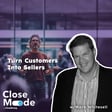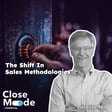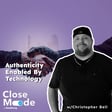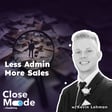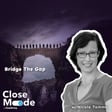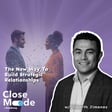Intro
Introduction to Closed Mode
00:00:04
Brian
Hello, and welcome to another edition of Closed Mode, the enterprise sales show. I'm Brian Deetmeyer, CEO of Closed Strong. And today I'm super lucky to be here with Kaylee Hogan, ah who's had multiple roles in sales enablement, most recently director of revenue enablement. And Kaylee, welcome to the show.
Human-Centric Enterprise Sales
00:00:23
Kayleigh Hogan
much for having me. I really admire what you're talking about with people here and exploring enterprise sales and then tying in RevOps and Enablemen and seeing the whole go-to-market machine together and thinking about it in ah in a closing fashion it's is really admirable.
00:00:37
Brian
Well, yeah, and and it's it's we I feel like lately, maybe kind of on purpose, we've been leaning into the human issue and stuff. And when you and I were speaking last week about just the human side of of enterprise selling, and and one of the conversations we were having ah is about sort of implementation and adoption, which
00:00:56
Brian
is like, everybody's frustrated with, we just rolled out this tool, we just rolled out this training, you know, and no nobody's using it.
00:01:03
Brian
And and you mentioned um some sort of pretty spectacular ah adoption rates. And then you started talking to me about design thinking. and empathy mapping and and since then I've actually done a little work on understanding both and they're both like unbelievably tied to the human side of stuff. so
Design Thinking in Sales Enablement
00:01:22
Brian
But for for our listeners, can you define design thinking and empathy mapping at a high level?
00:01:28
Kayleigh Hogan
Yeah, definitely. um So design thinking is more of a nonlinear process that where it was designed and implemented in the 1960s. And they were trying to tie it to other core learning concepts, so like science and and just the human side of things. So just adding a little bit more scientific application to it. um it it hads It encompasses a few different steps, the first one being empathize, which to me, you know I worked at a company whose main motto was empathy. And that's actually where I learned the concept of design thinking and empathy mapping.
00:02:02
Kayleigh Hogan
So the first step is empathize. You have to understand and have a human centered approach to problem solving ah before you can go on and start to define what the the problem is and what the solution might be. Then you start to ideate on the potential solutions. Then you prototype. So you come up with a couple of different options for those users to test and then you test with them and you create feedback loops. And so I mentioned a second ago that it's nonlinear. So say you get, you know, with, especially in the world of software, things are changing so rapidly.
00:02:35
Kayleigh Hogan
Maybe you get halfway through designing an AI product today and your biggest competitor launches one and you're just like, you know what? No, we're going to double down on this other area that we're really strong. we're going to pull out of the ideate phase and we're going to go back to empathize and try to understand what our users are meeting. So I'm a huge fan of making it more centered around the end user of something. And so in enablement, I read the study last year but by seismic that talked about how two thirds of all content does not get used in an organization.
00:03:06
Kayleigh Hogan
I pour my heart and my soul into the content that I create and to know that stuff that I stay up late at night isn't getting used, like that breaks my heart.
00:03:13
Kayleigh Hogan
But that also indicates to me that there's a bigger problem, that I didn't design it in a way that's actually helpful to the end user. And when it comes to enterprise sales, I've joined organizations that have 3,000 to 10,000 different pieces of content they want their sales team to know about or be able to find and and leverage at certain points of
Empathy Mapping in Sales Enablement
00:03:34
Kayleigh Hogan
the sales cycle. And so that's where I just started. I saw the the history of it and how it was being pulled into product management. There are a couple of books on design thinking and enablement. And that was just where, like I have goosebumps about it.
00:03:45
Kayleigh Hogan
Like my degree is in psychology.
00:03:46
Kayleigh Hogan
So um helping people feel seen and heard is the first step to getting to buy.
00:03:52
Brian
Well, yeah, and and that that was such, and we'll we'll talk about your sort of results and and adoption rates in a moment.
00:03:58
Brian
I want to ask you about those. But when when you talked about the empathy mapping part, like I made, as you were talking through that and and the the additional research I did, it's the thought feelings and experiences of of of people.
00:04:12
Brian
and And it occurred to me that like you were using that to make the decision on on how and what kind of should should be rolled out. And I feel like that is such a different approach. There's a lot of surveys and maybe some focus groups, but there's not so much emphasis on on the the human part. um Can you talk a little bit about that empathy mapping and and how that how you think that got sort of stakeholder buy-in up front?
00:04:38
Kayleigh Hogan
Yeah, definitely. So empathy maps are going to, they're highly visual and I've created a template. Um, they were originally designed by a gentleman named David Dave gray out of X plane. He's a consulting group. He was the co-founder. And the whole point was either in individual settings, small group settings or large group settings. being able to capture what everyone is seeing, saying, hearing, and doing with regards to a existing process or problem, or maybe in regards to something that you're trying to roll out and see if it's going to work.
00:05:11
Kayleigh Hogan
So the first point of being able to um you know understand what people are doing, and especially in enablement, my stakeholders are usually the sales leaders, the sales team, the post sales team, the pre-sales team, the sales ops team, the ah CRO, and some of the XLT.
00:05:29
Kayleigh Hogan
And so ah going into any type of program that I'm working on and developing, I need to understand what all of these people, all these stakeholders are experiencing right now before I can, because I'm not going to just solve it with training. I need to solve it in a multifaceted approach in order to meet all of these these learners and stakeholders where they're at. so If I gather an empathy map and I say, hey, what are you guys seeing in the environment right now?
00:05:56
Kayleigh Hogan
What do you what are you where are you not seeing? What are you saying? What have you heard others say? what are what are you What do you think you could be saying? What do I think you could be saying? What are you hearing? What are you hearing from your manager? What are you hearing from your peers? What are you hearing from your friends and family or from LinkedIn, the industry?
00:06:11
Kayleigh Hogan
What are you saying or what are you, sorry, what are you doing? And then, um, so what, are you know, what have you observed or what are we observing you doing, et cetera. So those four things are going to be the first piece. And then finally you ask those people on an either individual basis or as a group collectively, like what pains are you experiencing today regarding this process? What gains are you looking to gain in a future version of it? And then my favorite thing to do as an enabler is to bring either all of those stakeholders or a subset of them back together in kind of a forum and give them a readout of what they all said to me. If I, if I collected the results individually or I'll bring them back later on after we've all had some time to kind of
00:06:52
Kayleigh Hogan
process what we what we've documented together and then we start talking about, okay, ideas.
00:06:57
Brian
See, and yeah, I'm i'm sorry, Kaylee, I think that like, that's the part where I feel like, you know, for for those naysayers that like, Oh, this is all soft. Like if I'm going to anticipate what someone might push back on, right. is that it's soft. And for me, going back to the stakeholders and say, this is what you heard, this is what you felt, um I believe that that that's where you start getting buy-in and we just don't spend enough time there. And I'm wondering, kind of three three questions. So we we have to collect this stuff.
00:07:28
Brian
And then you you talked about a map, we have to analyze it in some way. And then I'm wondering about outputs and insights. So let's go to the first one. um How are you collecting this? Is it surveys? Is it focus groups? Is it voice?
00:07:40
Kayleigh Hogan
Yeah, um you can do it. Honestly, it depends on what kind of problem you're trying to solve and how big of a group you're trying to get information from. um I've leveraged empathy maps at companies that are 6,000 people and I've leveraged them at companies where we have 37 people. you know so ah You can individually interview people and capture that information. That's usually my favorite way to do it, Brian, because it allows us to be human with each other.
00:08:05
Kayleigh Hogan
It allows you to not have to worry about what someone over there is going to think or feel about what you're saying in relaying your experience. Like, for instance, if we have a sales process where we're getting stuck right in like proof of concept or something. and I go and I ask the sales reps or I ask a top couple top performing sales reps, why are we getting stuck here in proof of concept?
Collecting and Analyzing Feedback
00:08:27
Kayleigh Hogan
They're probably not gonna say to me in a group setting, well, my manager really likes to go and look through every single detail of this, i.e.
00:08:35
Kayleigh Hogan
they're a micro manager and so I get stuck here and my deals stall and me they lose the amount of time as the killer of all deals. So they're probably not gonna say that in a group setting. So depending on the problem, you'll wanna, decide how you gather the information. If you're trying to move really quickly, doing it in a large group setting and giving everyone sticky notes and just putting a really big empathy map on a whiteboard is a good way to get some progress.
00:08:58
Kayleigh Hogan
You can even do it virtually.
00:09:00
Kayleigh Hogan
um Small groups, again, you can just have a couple of interviewers that are gathering notes. and interviewing people, but my favorite is doing just a virtual coffee like you and I are chatting now and just saying, hey Brian, umm I'm taking over the the strategic account planning process here at XYZ Co. And I just, you know, I noticed that you're someone who owns a lot of the account plans or the strategic plans that should be account plans. And I just want to understand like, what's your perspective on it? So can I ask you a couple of questions around what are you seeing? What are you saying? What are you hearing? What are you doing? What gains are you experiencing today and what gains are you looking to experience tomorrow in this version?
00:09:34
Kayleigh Hogan
And as soon as they get through communicating all of that to me, Brian, they're a little bit more bought in to what I come back to them with as a prototype. That's my favorite.
00:09:43
Brian
Yeah, i i I agree. And when when I think about analyzing that data and you you talked about empathy maps, you know, I've seen the the word maps that are cool that you can get from, yeah you know, conversational intelligence tools, that sort of thing.
00:09:55
Brian
And I'm wondering um what what you use. I could also see even throwing that stuff into, you know, Gemini and saying, okay, give give me, you know, give me the the kind of summary. But yeah, what what are you using to to pull that together visually and otherwise?
00:10:10
Kayleigh Hogan
I love that question. Thank you so much. um I've done it a couple of different ways. I'm a big fan of, um yeah, you could throw it into some AI and have it do a word cloud for you. Back when I was first doing my my first empathy maps, I would use an actual word word cloud generator and I would just copy everyone's responses or my notes and I'd put them in there and then have it give me the themes.
00:10:29
Kayleigh Hogan
But my favorite way to do it is to create a summary empathy map. and say these are the common themes I'm hearing in each one of these categories. This is what I'm hearing collectively across you guys around seeing, saying, hearing and doing. Here are the problems and the the pains that you're experiencing and here's the gains we're all looking to collectively.
00:10:49
Kayleigh Hogan
you know, get in the next version. So based on that information, stakeholders, here's my three ideas for how we address
Engaging Stakeholders Effectively
00:10:55
Kayleigh Hogan
this problem. Which two should we put some time and resource in and you give me feedback on?
00:10:59
Kayleigh Hogan
Because I don't want to take too much time out of your day selling. You only get 39% of your time in front of a customer actually selling. So I want to minimize the amount that I'm asking you for stuff, but I also want to maintain your buy-in.
00:11:11
Brian
Yep, and i I'm going to sneak in a question and I imagine people know that that i've I've prepped you with some of the things I want to talk about, but this one I didn't and it it occurs to me like um I'm wondering, I'm going back to sort of confidence level and statistical validation. like is is can Can that be provided with an empathy map to say I know within 95% confidence that this is kind of What what the group feels on this thing? You know and then we can get that how does that impact what we're rolling out? But yeah, what's what's the level of of that sort of analysis?
00:11:40
Kayleigh Hogan
twenty Yeah, um I guess you're giving me ideas for a company that I should maybe start in leveraging AI and to do something to that effect. So thank you for that idea.
00:11:50
Kayleigh Hogan
Be a co-founder, let me know. um So you when you gather stakeholders and you give them that readout, sometimes there is a bit of disagreement. And especially if it's from like a leader, maybe that doesn't have the same perspective on that process as the rest of the group. And that's when you might want to be a bit more strategic in how you regroup the stakeholders.
00:12:11
Kayleigh Hogan
So instead of having like for my sales advisory board, I like having a couple of folks and from enterprise and commercial and mid market and small to medium business. I like having top performers, moderate, medium performers that want to be top performers, and then maybe some lower performers that are kind of like, am here because I'm here. So I like to ask all of them questions and get their feedback as well. And so I'm going to have some diverse answers there. Usually leaders don't always agree. So I'm going to want to have a subset of those stakeholders in the readout. And then I can say, hey, I'm you know i'm not going to break confidentiality of who specifically said this, but I have enough you know conversations with people to see this as a theme. And if we don't think this is a theme, then let's build a couple of prototypes with that in mind. and if
00:12:59
Kayleigh Hogan
We come back and we empathy map again, and that becomes a ah thing that bubbles up again. We need to have an honest conversation about it.
00:13:07
Kayleigh Hogan
You're right.
00:13:07
Kayleigh Hogan
There's not as much metric behind it, but it is about, again, going back to the humanist. It's not, oh, and I loved at the recent Sales and Enablement Collective conference I was at, they talked about how you have to tie back to one performance metric in enablement. We sometimes try to tie to too many things.
00:13:23
Kayleigh Hogan
And I think before you can go in and empathy map, you have to say, what problem are we trying to solve? And what what are we going to say success looks like? What does good look like coming out the other side of this? Or what's the expectation? And then we can leverage kind of that metric and align the perspectives we're getting from people to that metric in the future. state
00:13:45
Brian
it It's interesting because I didn't realize this, but we we do a thing called a diagnostic and we get we we run some surveys that do have some, you know, statistical analysis we can do we in benchmarking, but we also do a
Empathy Mapping Best Practices
00:13:57
Brian
lot of interviews. And I think we might be doing empathy mapping because it's one of the tee ups is, you know, if I'm interviewing you, okay, Kaylee, ah You know, you're safe to say whatever you need to say in this interview. and And I might use quotes, but I'm never going to put your name next to anything. And it's interesting because after, you know, seven or eight interviews of executives, two or three themes pop up.
00:14:22
Brian
We'll then typically throw a couple illustrative quotes. Like along with those, and and it's interesting what we hear more often than not is, yup, you nailed it. That's it. and And there isn't any math behind that, but it's very rare. Um, and, and the themes emerge pretty quickly. I wonder if you find that too, because I, I often say, you know, after the third interview, I kind of already know what the two or three themes are going to be. And then I can double click on subsequent interviews to get under what those themes are.
00:14:47
Kayleigh Hogan
Exactly. Exactly. It does sound like you're doing your own version of empathy mapping, first of all, and I agree.
00:14:53
Kayleigh Hogan
um When I join a new organization, I like to go and empathy map top performers. I actually have one sitting somewhere on my desk from when I joined a company and I went and talked to one of my sales leaders that was going to be a stakeholder of mine. I just literally drew the the box on my my paper like this. Hold on, I'm just drawing, I'm drawing you the most ugly sticky notes. So I've got this little box here.
00:15:14
Kayleigh Hogan
So you can say, see, hear, feel, say do, and then pains and gains. So I literally just on a piece of paper, I'm writing that out and I'm talking to him about it. So we
00:15:24
Brian
Wait, who who needs who needs Google Slides or PowerPoint? We have stickies.
00:15:28
Kayleigh Hogan
have stickies or piece of paper, I just going back to the human bit, I actually do feel like when If you're taking notes, or like I've collected empathy maps in forums and and in surveys and stuff.
00:15:40
Kayleigh Hogan
But i again, I just, I think if you have a conversation with people and you let them know, I'm not doing this to try to collect data that's going to get anyone in trouble.
00:15:48
Kayleigh Hogan
I want to actually understand why account planning is not getting adopted. Oh, it's taking you guys 15 hours, 15 plus hours to manually create one. and you review it for 30 minutes with your leadership team and then it collects digital dust for a year so you don't see the point in investing that time. That makes a lot of sense. What if I was able to cut that time in half or even into an eighth of that amount of time?
00:16:12
Kayleigh Hogan
Would you be more interested in doing it for your top deals? Okay, cool. Now we're plugged in. But yeah, you're right. You can double click a little bit further once you've kind of gone in and seen what's their general perspective on, you know, things today and then you can get more specific and empathy map an existing process problem or something you want to move towards. So maybe like a new sales methodology or ah a new buyer interview program or a new win back we win review reform or something like that.
00:16:41
Brian
Yeah. Well, one one of the things that hooked me or early on in ah in our previous conversation, um you gave me some sort of implementation and
Account Planning Challenges and Solutions
00:16:50
Brian
So there was an initiative. And and um can you talk a little bit about about the the evidence for for that initiative?
00:16:57
Brian
Like at at what rate was it adopted? And and how would you how would you correlate the design of that thing to to this implementation?
00:17:05
Kayleigh Hogan
yeah so oh'll Yeah. yeah, I, I'm not gonna lie. It's been a few years and I was doing my calculations very manually in a spreadsheet. So if you're going to be like, what was your exact formula for calculating this?
00:17:16
Kayleigh Hogan
I'll be like, let me get back to you. But the more, the general gist was I joined a large enterprise CCAS company that sells contact centers to everything from a mom and pop shop that needs someone to answer their phones or it needs a phone system to route things and an IVR, et cetera. IVR is interactive voice response system. So that's the thing that's like, I'll press one to go to sales, blah, blah, blah.
00:17:40
Kayleigh Hogan
So um I joined that company and they were saying, hey, we we need strategic account plans for the top 5,000 accounts at this company because they are targeting the top 20 accounts and the top 20 companies that have, you know, the F 20.
00:17:56
Kayleigh Hogan
and all the way down to small to medium business.
00:17:58
Kayleigh Hogan
And they felt like at least 5,000 of those accounts, especially in the enterprise and top part of the business needed an account plan. So um for them an account plan was an organizational chart, you know what's going on and in that organization. So say you're selling to like Delta Airlines. So who are we talking to at Delta Airlines? What's the main goal that the CEO has put in place this year? What are the main initiatives they're trying to organize to contribute towards that goal? Who's responsible for them? And then where do we fit in? What other solutions and programs are they putting out to contribute to these things?
00:18:31
Kayleigh Hogan
And how are we aligning to those stakeholders? This is a lot of really great information and sales reps have to communicate it to their leadership and usually verbally a lot throughout their sales process.
00:18:42
Kayleigh Hogan
And it gets annoying for them. So capturing it in an account plan kind of makes sense because then you can, when someone asks you for it, you can just point them to that piece of information and then they can come to you with that layer deeper of questions like we just talked about. So for them, it was a very manual process where sales reps were going in and manually creating slides and not to bash on sales reps, creativity and slide creation, but it wasn't consistent and it wasn't graded well.
00:19:08
Kayleigh Hogan
it It didn't, you know, it was trying to look more complex than it was. And it was really difficult for them to create them. And it was really difficult for the leadership team to to understand data out of it. So I came in and they were like, you get the account planning program. And I was like,
00:19:26
Kayleigh Hogan
Oh, what do I do with this? And there were only a couple hundred, I think there was under 200 account plans initially. And when I started to do empathy mapping, I i empathy mapped with some of the AEs that were doing them, some of the AEs that weren't doing them and should be doing them, their sales leaders, again, some of the ones that were really big fans of account plans, and then others that were kind of like, and I'm more into the transactional deal piece, come back when you have some pipeline.
00:19:51
Kayleigh Hogan
ah So, and then I, you know, kind of lost my train of thought there. so Then I chatted with those you know folks and I understood, hey, this is these are all the little issues that we have around this account planning process.
00:20:03
Kayleigh Hogan
and Then i i when I started to understand, I learned that the SEs were also being pulled in and the solutions architects were being pulled in. I uncovered that it was taking them 15 plus hours to make these plans. and I was like, well, no wonder you guys aren't doing them.
00:20:18
Kayleigh Hogan
so I then started coming up with some requirements with them. That was kind of that gains category from the empathy map.
00:20:25
Kayleigh Hogan
What things are you guys looking to get from this next version of account planning?
00:20:30
Kayleigh Hogan
And so I went and found a few different tools, got some demos from them, showed those kind of condensed versions of those demos to my stakeholders, got it down to three, piloted those three. then launched one of them. I helped you know build and test it and our Salesforce sandbox. And then all of those people that I empathy mapped with were my advisory board. They're my sales advisory board that would go in and test it and throw rotten tomatoes at it. And I i loved it. they They were always like, I feel like I'm being mean. And I was like, no, I actually want you to use this.
00:21:02
Kayleigh Hogan
You are going to be the one using this. And if there's anything in here that makes you go, I want to get up and go make a cup of coffee, that's where I need to focus. I want you to talk to me about that.
00:21:11
Brian
Yep. Well, and what what's what strikes me too, and anybody who's listened to more than a few episodes know, I'm ah i' a huge, and my partner's on all this, a huge fan of Slow Down to Hurry Up.
00:21:12
Kayleigh Hogan
so Yeah. yeah
00:21:21
Brian
And for people that are unbelievably action-oriented, all they hear is the slow down.
Successful Adoption of New Tools
00:21:26
Brian
And so, what what not that not the, oh, and we're going to hurry up later.
00:21:26
Kayleigh Hogan
Yeah. Yeah.
00:21:30
Brian
And what what I'm hearing is like this process, again, with the focus on implementation, adoption, change management, however we want to call that, This pre-work um driving the adoption later, and and I think it's funny because I think one one of the numbers either I read about your stuff or or you talked to me about was like 186%. I was wondering how we get to 186% adoption, but part part of it is because I think, umm so yeah, you took that time upfront that saved you a bunch of time in the backend because people actually made the change.
00:21:57
Kayleigh Hogan
Mm hmm. Yeah. Yes, exactly. So I used I leveraged all of those folks to like throw every rotten tomato they possibly could at it. And I there was one sales rep who was like, over 100% of quota. And he literally said to me when we got one of the demos, he was like, Kaylee, this is, this tool is meant for people that are at like 70% of quota.
00:22:19
Kayleigh Hogan
I'm at 100% of quota. I don't need this.
00:22:21
Kayleigh Hogan
And I was like, well, so-and-so when you, uh, when you hit 200% of your quota and you get to buy your next lake house, I get to come over and have a party with you. So that he, uh, he jokingly laughed about that. But anyway, when it came time to actually train the rest of the team on the account planning tool that we wound up choosing and leveraging and and creating an output for, I didn't even really have to lead the training. The sales reps and the sales leaders did.
00:22:46
Kayleigh Hogan
They were so bought into it. And that was what made the adoption.
00:22:51
Kayleigh Hogan
i'm getting Again, I'm getting goosebumps. it was it was the coolest I got program of the year for that program because they were so bought in.
00:22:58
Kayleigh Hogan
It wasn't just the shiny new thing. Everyone was bought in. And I even had small to medium business reps filling out account plans because you know when they have 1,000 accounts, they're like, how am I going to account plan for 1,000 accounts? And it's like, no, don't. don't Pick five that you actually think you might be able to land this year, or even in the first six months of this year, and do the account plan for those.
00:23:18
Kayleigh Hogan
Get all of your stakeholders bought in internally and externally on here's where we're at, here's the beat we're marching to, and here's how we're gonna get these people buy bought in so that they that we're trusted advisors and they wanna buy more and more and more from us. So anyway, I leveraged those folks to go in and train the rest of the team, and we went in under two months from 180 plus account plans to like,
00:23:41
Kayleigh Hogan
over a thousand, just like within a couple of weeks. Like everyone that attended that training went and created a couple of plans. I was looking at when people were logging in and I was seeing really consistent logging in, especially in that first six months. And even as I was exiting, the month over month adoption of that, those plans was 46%.
00:24:00
Kayleigh Hogan
So I was still seeing growth and people continuing to create plans.
00:24:04
Kayleigh Hogan
And this was, you know, a year and a half after it launched. So,
00:24:08
Brian
Yeah. And it's, it's.
00:24:08
Kayleigh Hogan
ah The 186% was going from that 180 to like the the thousand very short period of time.
00:24:15
Kayleigh Hogan
And then towards the end, it was the 46% month over month growth. And I, I sent it that to my SVP of sales ops and he sent me the nicest Slack message about how this program literally changed the trajectory
Impact of Account Planning Programs
00:24:27
Kayleigh Hogan
of the company.
00:24:27
Kayleigh Hogan
The chief of staff even presented account planning at at sales kickoff that year because they were like, this is the thing we all need to be doing. And now in 2024 with ah you know this macroeconomic climate we're in, I feel even more passionate about people having to do account plans, but you can't design a very big, ugly, complex account plan, or your reps aren't going to do it, or they're not going to adopt it over time.
00:24:51
Kayleigh Hogan
And so that was where the little piece came in.
00:24:52
Brian
Yeah. Well, and that it's, yeah, there's so many things
Addressing Post-Launch Reversions
00:24:57
Brian
that it's like, okay, this initiative, this thing, this accompanying thing, it's it's better, faster. And it's still, there's still the human change piece that I'm still going to do it the way I've always done it. I'm one of our board members and advisors. He, you know, he was talking to me about, he's like, here and you just said it. It's like, here's the thing, we're announcing SKO. And then after SKO, everybody goes back and does it the way they used to do it, right? And this and interrupts that flow.
00:25:22
Brian
and And he, you know, he's an industry analyst, been around for a while. and And he was like, this is such a huge problem. And that's why. I wanted to talk about this today because the the evidence is there, but it it takes it takes a little bit more work upfront to to begin to to get that buy-in, and and i I feel like that's missed.
00:25:36
Kayleigh Hogan
I completely agree.
00:25:44
Kayleigh Hogan
I completely agree.
00:25:44
Kayleigh Hogan
And I think in, an especially in supporting organizations like ops and enablement, Like, everything always feels really reactive, but I think the more we can step back and say, what problem are we actually trying to solve here? And that's why, again, I really like design thinking. This gentleman named Horace Rotel in like the 1960s came up with this term wicked problems, and these are going to be complex, ambiguous, non-yes or no problems that need to be solved.
00:26:12
Kayleigh Hogan
and then in the 90s, somebody named Richard, Richard Buchanan wrote this article called ah like wicked problems in design thinking, and he applied that whole concept around, we have to, when things are ambiguous, we really need to get back to that human side of it and That's what's actually going to drive the buy-in, not stats, not metrics, not, um, some person in every tower telling you you have to do something. It's really going and and taking that time at the front to be like, what does everyone think?
00:26:42
Kayleigh Hogan
What is your reality right now?
00:26:44
Kayleigh Hogan
What do you want it to be? And like, if I just stopped and asked you like, Hey, do you like just in your regular life as a human being, Brian, what do you, what do you, what do you need to be successful?
00:26:55
Kayleigh Hogan
What are you seeing? What are you saying? What are you hearing? What are you doing today to be successful? And what do you want to be doing tomorrow? All of a sudden you're like, holy crap, Kaylee. You don't just want to blab at me and
Human Elements in Design Thinking
00:27:06
Kayleigh Hogan
teach me something.
00:27:06
Kayleigh Hogan
You actually care about where I'm at.
00:27:08
Brian
Yep, and which which is why which is why I've been leaning into more of the human stuff on these because I feel like we don't we don't pay enough ah we don't pay enough attention to it at all.
00:27:09
Kayleigh Hogan
To me, that's.
00:27:18
Brian
And I have to guess, by the way, if I had to guess the the the wicked problem guys, that they might be Boston um people.
00:27:25
Brian
had that I mean, wicked.
00:27:26
Kayleigh Hogan
Probably, probably.
00:27:28
Kayleigh Hogan
hor Yeah. Yes.
00:27:28
Brian
I can hear the wicked wicked problem coming coming out of somebody, a Bostonian's mouth.
00:27:35
Brian
Yeah, you've been...
00:27:35
Kayleigh Hogan
Absolutely.
00:27:36
Brian
I love this topic. You've been super generous with your time and your ideas. And I also have to say one of the things that's very refreshing is is how much you care about this. There are very few people who get chills from the work that they do. so And you've mentioned that a couple of times and and and it's it's really helpful.
00:27:50
Kayleigh Hogan
Yeah. Yeah.
00:27:53
Brian
And i think I think you do have a link to resources. We'll make sure when we when we post these that we'll put we'll put a link if people want the deeper dive from this tease that we've given today.
00:28:04
Kayleigh Hogan
Definitely. Thank you.
Anecdotes and Closing Remarks
00:28:05
Kayleigh Hogan
I will say at that company, I was at sales kickoff. They held sales kickoff at like Universal Studios and in Florida. And ah we got to ride on a few roller coasters and stuff. They bought out part of the park. And I was literally talking to one of the leaders on the marketing team excitedly. about account planning and the empathy maps I did. And he literally grabbed my shoulders and was like, we are supposed to be having fun right now. And you were talking about work stuff and I get that you're excited about it, but we're going to talk about work stuff.
00:28:31
Kayleigh Hogan
And I was like, I am having fun talking about work stuff.
00:28:34
Brian
Right. exactly Exactly. Exactly.
00:28:36
Kayleigh Hogan
So anyway, I really appreciate the time.
00:28:36
Brian
Well, for, yeah, thank thank you.
00:28:38
Kayleigh Hogan
Thanks so much for watching me. And yeah, I'd love to share those resources.
00:28:42
Brian
and And for those um um moms and dads who who work from home and have kids, thank you for having your new baby at the park while we did this. So for anyone else who's had to do similarly, ah thank you.
00:28:51
Kayleigh Hogan
Yeah, of course. Yes, of course.
Outro




